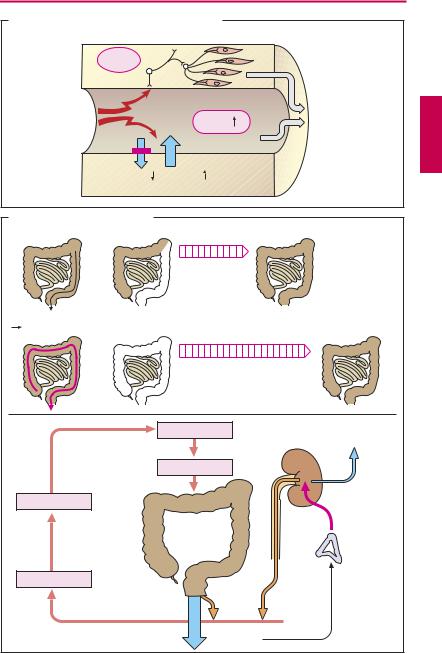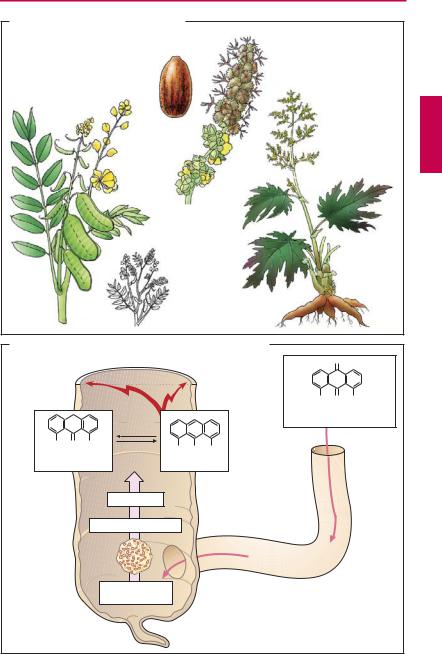
- •Preface to the 3rd edition
- •General Pharmacology
- •Systems Pharmacology
- •Therapy of Selected Diseases
- •Subject Index
- •Abbreviations
- •General Pharmacology
- •History of Pharmacology
- •Drug and Active Principle
- •The Aims of Isolating Active Principles
- •European Plants as Sources of Effective Medicines
- •Drug Development
- •Congeneric Drugs and Name Diversity
- •Oral Dosage Forms
- •Drug Administration by Inhalation
- •Dermatological Agents
- •From Application to Distribution in the Body
- •Potential Targets of Drug Action
- •External Barriers of the Body
- •Blood–Tissue Barriers
- •Membrane Permeation
- •Binding to Plasma Proteins
- •The Liver as an Excretory Organ
- •Biotransformation of Drugs
- •Drug Metabolism by Cytochrome P450
- •The Kidney as an Excretory Organ
- •Presystemic Elimination
- •Drug Concentration in the Body as a Function of Time—First Order (Exponential) Rate Processes
- •Time Course of Drug Concentration in Plasma
- •Time Course of Drug Plasma Levels during Repeated Dosing (A)
- •Time Course of Drug Plasma Levels during Irregular Intake (B)
- •Accumulation: Dose, Dose Interval, and Plasma Level Fluctuation (A)
- •Dose–Response Relationship
- •Concentration–Effect Curves (B)
- •Concentration–Binding Curves
- •Types of Binding Forces
- •Agonists—Antagonists
- •Other Forms of Antagonism
- •Enantioselectivity of Drug Action
- •Receptor Types
- •Undesirable Drug Effects, Side Effects
- •Drug Allergy
- •Cutaneous Reactions
- •Drug Toxicity in Pregnancy and Lactation
- •Pharmacogenetics
- •Placebo (A)
- •Systems Pharmacology
- •Sympathetic Nervous System
- •Structure of the Sympathetic Nervous System
- •Adrenergic Synapse
- •Adrenoceptor Subtypes and Catecholamine Actions
- •Smooth Muscle Effects
- •Cardiostimulation
- •Metabolic Effects
- •Structure–Activity Relationships of Sympathomimetics
- •Indirect Sympathomimetics
- •Types of
- •Antiadrenergics
- •Parasympathetic Nervous System
- •Cholinergic Synapse
- •Parasympathomimetics
- •Parasympatholytics
- •Actions of Nicotine
- •Localization of Nicotinic ACh Receptors
- •Effects of Nicotine on Body Function
- •Aids for Smoking Cessation
- •Consequences of Tobacco Smoking
- •Dopamine
- •Histamine Effects and Their Pharmacological Properties
- •Serotonin
- •Vasodilators—Overview
- •Organic Nitrates
- •Calcium Antagonists
- •ACE Inhibitors
- •Drugs Used to Influence Smooth Muscle Organs
- •Cardiac Drugs
- •Cardiac Glycosides
- •Antiarrhythmic Drugs
- •Iron Compounds
- •Prophylaxis and Therapy of Thromboses
- •Possibilities for Interference (B)
- •Heparin (A)
- •Hirudin and Derivatives (B)
- •Fibrinolytics
- •Intra-arterial Thrombus Formation (A)
- •Formation, Activation, and Aggregation of Platelets (B)
- •Inhibitors of Platelet Aggregation (A)
- •Presystemic Effect of ASA
- •Plasma Volume Expanders
- •Lipid-lowering Agents
- •Diuretics—An Overview
- •NaCl Reabsorption in the Kidney (A)
- •Aquaporins (AQP)
- •Osmotic Diuretics (B)
- •Diuretics of the Sulfonamide Type
- •Potassium-sparing Diuretics (A)
- •Vasopressin and Derivatives (B)
- •Drugs for Gastric and Duodenal Ulcers
- •Laxatives
- •Antidiarrheal Agents
- •Drugs Affecting Motor Function
- •Muscle Relaxants
- •Nondepolarizing Muscle Relaxants
- •Depolarizing Muscle Relaxants
- •Antiparkinsonian Drugs
- •Antiepileptics
- •Pain Mechanisms and Pathways
- •Eicosanoids
- •Antipyretic Analgesics
- •Nonsteroidal Anti-inflammatory Drugs (NSAIDs)
- •Cyclooxygenase (COX) Inhibitors
- •Local Anesthetics
- •Opioid Analgesics—Morphine Type
- •General Anesthesia and General Anesthetic Drugs
- •Inhalational Anesthetics
- •Injectable Anesthetics
- •Sedatives, Hypnotics
- •Benzodiazepines
- •Pharmacokinetics of Benzodiazepines
- •Therapy of Depressive Illness
- •Mania
- •Therapy of Schizophrenia
- •Psychotomimetics (Psychedelics, Hallucinogens)
- •Hypothalamic and Hypophyseal Hormones
- •Thyroid Hormone Therapy
- •Glucocorticoid Therapy
- •Follicular Growth and Ovulation, Estrogen and Progestin Production
- •Oral Contraceptives
- •Antiestrogen and Antiprogestin Active Principles
- •Aromatase Inhibitors
- •Insulin Formulations
- •Treatment of Insulin-dependent Diabetes Mellitus
- •Treatment of Maturity-Onset (Type II) Diabetes Mellitus
- •Oral Antidiabetics
- •Drugs for Maintaining Calcium Homeostasis
- •Drugs for Treating Bacterial Infections
- •Inhibitors of Cell Wall Synthesis
- •Inhibitors of Tetrahydrofolate Synthesis
- •Inhibitors of DNA Function
- •Inhibitors of Protein Synthesis
- •Drugs for Treating Mycobacterial Infections
- •Drugs Used in the Treatment of Fungal Infections
- •Chemotherapy of Viral Infections
- •Drugs for the Treatment of AIDS
- •Drugs for Treating Endoparasitic and Ectoparasitic Infestations
- •Antimalarials
- •Other Tropical Diseases
- •Chemotherapy of Malignant Tumors
- •Targeting of Antineoplastic Drug Action (A)
- •Mechanisms of Resistance to Cytostatics (B)
- •Inhibition of Immune Responses
- •Antidotes and Treatment of Poisonings
- •Therapy of Selected Diseases
- •Hypertension
- •Angina Pectoris
- •Antianginal Drugs
- •Acute Coronary Syndrome— Myocardial Infarction
- •Congestive Heart Failure
- •Hypotension
- •Gout
- •Obesity—Sequelae and Therapeutic Approaches
- •Osteoporosis
- •Rheumatoid Arthritis
- •Migraine
- •Common Cold
- •Bronchial Asthma
- •Emesis
- •Alcohol Abuse
- •Local Treatment of Glaucoma
- •Further Reading
- •Further Reading
- •Picture Credits
- •Drug Indexes

174 Laxatives
Laxatives
Laxatives promote and facilitate bowel evacuationbyactinglocallytostimulateintestinal peristalsis, to soften bowel contents, or both.
1. Bulk Laxatives
Distension of the intestinal wall by bowel contents stimulates propulsive movements of the gut musculature (peristalsis). Activation of intramural mechanoreceptors induces a neurally mediated ascending reflex contraction (red in A) and descending relaxation (blue) whereby the intraluminal bolus is moved in the anal direction.
Hydrophilic colloids or bulk gels (B) comprise insoluble and nonabsorbable substances that expand on taking up water in the bowel. Vegetable fibers in the diet act in this manner. They consist of the indigestible plant cell walls containing homoglycans that are resistant to digestive enzymes, e.g., cellulose (1† 4β-linked glucose molecules vs. 1† 4α-glucoside bond in starch; p.157). Bran, a grain milling waste product, and linseed (flaxseed) are both rich in cellulose. Other hydrophilic colloids derive from the seeds of Plantago species or karaya gum. Ingestion of hydrophilic gels for the prophylaxis of constipation usually entails a low risk of side effects. However, when fluid intake is very low and a pathological stenosis exists in the bowel, mucilaginous viscous materials could cause an ileus.
Osmotically active laxatives (C) are soluble but nonabsorbable particles that retain water in the bowel by virtue of their osmotic action. The osmotic pressure of bowel contents always corresponds to that of the extracellular space because the intestinal mucosa is unable to maintain a higher or lower osmotic pressure of the luminal contents. Therefore, absorption of molecules (e.g., glucose, NaCl) occurs iso-osmotically, i.e., solute molecules are followed by a corresponding amount of water. Conversely, water remains in the bowel when molecules cannot be absorbed.
With Epsom salt (MgSO4) and Glauber’s salt (Na2SO4), the SO42- anion is hardly absorbable and retains cations to maintain electroneutrality. Mg2+ ions are also believed to promote release of cholecystokinin/pancreozymin, a polypeptide that also stimulates peristalsis, from the duodenal mucosa. These so-called saline cathartics elicit a watery bowel discharge 1–3 hours after administration (preferably in isotonic solution). They are used to purge the bowel (e.g., before bowel surgery) or to hasten the elimination of ingested poisons. Contraindications arise because a small part of cations is absorbed. Thus, Glauber’s salt is contraindicated in hypertension, congestive heart failure, and edema because of its high Na+ content. Epsom salt is contraindicated in renal failure (risk of Mg2+ intoxication).
Osmotic laxative effects are also produced by the polyhydric alcohols mannitol and sorbitol, which unlike glucose cannot be transported through the intestinal mucosa.
Since the disaccharide lactulose cannot be hydrolyzed by digestive enzymes, it also acts as an osmotic laxative. Fermentation of lactulose by colon bacteria leads to acidification of bowel contents and a reduced number of bacteria. Lactulose is used in liver failure to forestall hepatic coma by preventing bacterial production of ammonia and its subsequent absorption (absorbable NH3 † nonabsorbable NH4+). Another disaccharide, lactitol, produces a similar effect.
Luellmann, Color Atlas of Pharmacology © 2005 Thieme
All rights reserved. Usage subject to terms and conditions of license.

|
|
|
|
|
|
|
|
|
|
Laxatives |
175 |
A. Stimulation of persistalsis by an intraluminal bolus |
|
|
|
|
|||||||
|
|
|
|
|
|
Stretch receptors |
|
|
|
|
|
Contraction |
|
|
|
|
|
|
Relaxation |
|
|||
B. Bulk laxatives |
|
|
|
|
|
|
|
|
|||
H2O |
|
|
|
|
|
H2O |
|
|
|
|
|
Cellulose, agar-agar, bran, linseed |
|
|
|
|
|
||||||
C. Osmotically active laxatives |
|
|
|
|
|
||||||
|
|
|
H2O |
|
|
|
|
|
|
|
|
H2O |
Na+, Cl- |
H2O |
|
|
H |
O |
|
||||
H2O |
|
|
|
||||||||
|
|
|
C |
|
|
||||||
Na+, Cl- |
Na+, Cl- |
|
|
HC |
OH |
|
|||||
H |
|
O |
H2O |
H O |
|
G |
|
|
|||
|
|
|
|
H2O |
|
||||||
2 |
|
Na+, Cl- |
2 |
|
HO |
|
|
||||
|
|
|
|
|
|
H2O |
CH |
|
|||
H2O H2O |
H2O |
|
|
|
G |
|
|||||
- |
H2O |
|
HC OH |
|
|||||||
+ |
, Cl |
- |
+ |
, Cl |
|
HC |
OH |
|
|||
Na |
H2O |
Na |
|
|
G |
|
|||||
H2O |
H2O |
|
Iso-osmotic |
|
|
|
|||||
Na+, Cl- |
|
|
H2C |
OH |
|
||||||
|
|
|
H2O |
|
|
|
absorption |
G = Glucose |
|
||
H2O |
|
|
H2O |
|
H2O |
|
|
|
|
|
|
Na+, Cl- |
|
|
Na+, Cl- |
Na+, Cl- |
|
|
|
|
|
||
H2O |
|
|
H2O |
|
H2O |
|
|
|
|
|
|
|
|
|
H2O |
|
|
|
|
|
H2O |
|
|
|
|
|
Na+, Cl- |
|
|
|
|
|
|
||
|
|
|
H2O |
|
|
|
|
G |
|
|
|
|
|
|
|
|
|
|
|
|
|
|
|
H2O |
|
|
H2O |
|
H2O |
G |
|
|
G |
|
|
Na+, Cl- |
|
|
Na+, Cl- |
Na+, Cl- |
H O |
|
|
H O |
|
||
H2O |
|
|
H2O |
|
H2O |
2 |
|
|
2 |
|
|
|
|
|
|
|
|
|
|
||||
H2O
2 Na+ SO |
2- |
H O |
H |
O |
|
4 |
2 |
2 |
|
H2O
HO |
H2C |
|
OH |
|||
|
||||||
|
|
|
|
|
||
|
CH |
|
||||
|
|
|||||
HO |
|
|
|
|
|
|
|
CH |
|
||||
|
|
|||||
|
HC |
|
|
|
OH |
|
|
|
|||||
|
|
|
|
|||
|
|
|
|
|
|
|
|
HC |
|
OH |
|||
|
|
|||||
|
|
|
|
|
||
|
H2C |
|
OH |
|||
|
|
|||||
Mannitol
H2O
Luellmann, Color Atlas of Pharmacology © 2005 Thieme
All rights reserved. Usage subject to terms and conditions of license.

176 Laxatives
2. Irritant Laxatives
Laxatives in this group exert an irritant action on the enteric mucosa (A). Consequently, less fluid is absorbed than is secreted. The increased filling of the bowel promotes peristalsis; excitation of sensory nerve endings elicits enteral hypermotility. According to the site of irritation, one distinguishes the small-bowel irritant castor oil from the large-bowel irritants anthraquinone and diphenylmethane derivatives (for details see p.178).
Misuse of laxatives. It is a widely held belief that at least one bowel movement per day is essential for health; yet three bowel evacuations per week is quite normal. The desire for frequent bowel emptying probably stems from the time-honored, albeit mistaken, notion that absorption of colon contents is harmful. Thus, purging has long been part of standard therapeutic practice. Nowadays it is known that intoxication from intestinal substances is impossible as long as the liver functions normally. Nonetheless, purgatives continue to be sold as remedies to “cleanse the blood” or to rid the body of “corrupt humors.”
There can be no objection to the ingestion of bulk substances for the purpose of supplementing low-residue “modern diets.” However, use of irritant purgatives or cathartics is not without hazards. Specifically, there is a risk of laxative dependence, i.e., the inability to do without them. Chronic intake of irritant purgatives disrupts the water and electrolyte balance of the body and can thus cause symptoms of illness (e.g., cardiac arrhythmias secondary to hypokalemia).
Causes of purgative dependence (B). The defecation reflex is triggered when the sigmoid colon and rectum are filled. A natural defecation empties the descending colon. The interval between natural stool evacuations depends on the speed with which this colon segment is refilled. A large-bowel irritant purgative clears out the entire colon.
Accordingly, a longer period is needed until the next natural defecation can occur. Fearing constipation, the user becomes impatient and again resorts to the laxative, which then produces the desired effect as a result of emptying out the upper colonic segments. Thus, a “compensatory pause” following cessation of laxative use must not give cause for concern (B).
In the colon, semifluid material entering from the small bowel is thickened by absorption of water and salts (from about 1000 ml to 150 ml per day). If, owing to the action of an irritant purgative, the colon empties prematurely, an enteral loss of NaCl, KCl and water will be incurred. In order to forestall depletion of NaCl and water, the body responds with an increased release of aldosterone (p.168), which stimulates their reabsorption in the kidney. However, the action of aldosterone is associated with increased renal excretion of KCl. The enteral and renal K+ losses add up to K+ depletion of the body, evidenced by a fall in serum K+ concentration (hypokalemia). This condition is accompanied by a reduction in intestinal peristalsis (bowel atonia). The affected individual infers “constipation” and again partakes of the purgative, and the vicious circle is closed.
Luellmann, Color Atlas of Pharmacology © 2005 Thieme
All rights reserved. Usage subject to terms and conditions of license.

|
|
|
|
Laxatives |
|
177 |
A. Stimulation of peristalsis by mucosal irritation |
|
|
|
|||
|
|
Reflex |
|
|
|
|
|
Irritation |
|
|
Peristalsis |
|
|
|
of mucosa |
|
Filling |
|
|
|
|
|
Absorption |
Secretion |
|
|
|
|
|
of fluid |
|
|
|
|
B. Causes of laxative habituation |
|
|
|
|
||
|
|
|
Interval |
|
|
|
|
|
|
needed to |
|
|
|
|
|
|
refill colon |
|
|
|
Normal filling |
After normal |
|
|
|
|
|
|
defecation reflex |
evacuation of colon |
|
|
|
|
|
|
|
Longer interval needed |
|
|
|
|
|
|
to refill rectum |
|
|
|
1 |
Laxative |
|
|
|
|
|
|
|
|
“Constipation” |
Renal retention |
||
|
|
|
|
of Na+, H |
2 |
O |
|
|
|
|
|
|
|
|
|
|
Laxative |
|
|
|
|
Bowel inertia |
|
|
|
|
|
|
|
|
|
Aldosterone |
||
|
Hypokalemia |
|
|
Renal |
|
|
|
|
|
|
|
|
|
|
|
Enteral |
loss |
|
|
|
|
|
loss of K+ |
of K+ |
|
|
|
2 |
|
|
Na+, H2O |
|
|
|
Luellmann, Color Atlas of Pharmacology © 2005 Thieme
All rights reserved. Usage subject to terms and conditions of license.

178 Laxatives
2a. Small-Bowel Irritant Purgative Ricinoleic acid. Castor oil comes from Ricinus communis (castor bean; panel A: sprig, panicle, seed). The oil is obtained from the first cold-pressing of the seed (shown in natural size). Oral administration of
10–30 ml of castor oil is followed within 0.5–3 hours by discharge of a watery stool. Ricinoleic acid, but not the oil itself, is active. The acid arises as a result of the regular processes involved in fat digestion: the duodenal mucosa releases the enterohormone cholecystokinin/pancreozymin into the blood. The hormone elicits contraction of the gallbladder and discharge of bile acids via the bile duct, as well as release of lipase from the pancreas (intestinal peristalsis is also stimulated). Lipase liberates ricinoleic acids from castor oil; these irritate the small bowel and thus stimulate peristalsis. Because of its massive effect, castor oil is hardly suitable for the treatment of ordinary constipation. It can be employed after oral ingestion of a toxin in order to hasten elimination and to reduce absorption of toxin from the gut. Castor oil is not indicated after the ingestion of lipophilic toxins likely to depend on bile acids for their absorption.
2b. Large-Bowel Irritant Purgatives
Anthraquinone derivatives are of plant origin. They occur in the leaves (Folia sennae) or fruits (Fructus sennae) of the senna plant, the bark of Rhamnus frangulae and Rh. purshiana (Cortex frangulae, Cascara sagrada), the roots of rhubarb (Rhizoma rhei), or the leaf extract from Aloë species. The structural features of anthraquinone derivatives are illustrated by the prototype structure depicted in panel (B). Amongothersubstituents,theanthraquinone nucleus contains hydroxyl groups, one of which is bound to a sugar (glucose, rhamnose). Following ingestion of galenical preparations or of the anthraquinone glycosides, dischargeofsoftstooloccursafteralatencyof 6–8 hours. The anthraquinone glycosides themselves are inactive but are converted by colon bacteria to the active free aglycones.
Diphenolmethane derivatives were developed from phenolphthalein, an accidentally discovered laxative, use of which had been noted to result in rare but severe allergic reactions. Bisacodyl and sodium picosulfate are converted by gut bacteria into the active colon-irritant principle. Given by the enteral route, bisacodyl is subject to hydrolysis of acetyl residues, absorption, conjugation in liver to glucuronic acid (or also to sulfate), and biliary secretion into the duodenum. Oral administration is followed after ~ 6–8 hours by discharge of soft formed stool. When given by suppository, bisacodyl produces its effect within one hour.
Indications for colon-irritant purgatives are the prevention of straining at stool following surgery, myocardial infarction, or stroke; and provision of relief in painful diseases of the anus, e.g., fissure, hemorrhoids.
Purgatives must not be given in abdominal complaints of unclear origin.
3. Lubricant laxatives
Liquid paraf n (paraf num subliquidum) is almost nonabsorbable and makes feces softer and passed easier. It interferes with the absorption of fat-soluble vitamins by trapping them. The few absorbed paraf n particles may induce formation of foreignbody granulomas in enteric lymph nodes (paraf nomas). Aspiration into the bronchial tract can result in lipoid pneumonia. Because of these adverse effects, its use is not advisable.
Antiflatulents (carminatives) serve to alleviate meteorism (excessive accumulation of gas in the gastrointestinal tract). Aboral propulsion of intestinal contents is impeded when these are mixed with gas bubbles. Defoaming agents, such as dimeticone (dimethylpolysiloxane) and simethicone, in combination with charcoal, are given orally to promote separation of gaseous and semisolid contents.
Luellmann, Color Atlas of Pharmacology © 2005 Thieme
All rights reserved. Usage subject to terms and conditions of license.

Laxatives 179
A. Plants containing laxative substances
Ricinus communs
|
|
|
|
|
|
Chinese |
|
|
|
|
|
|
Rhubarb |
Senna |
|
|
|
|
|
|
B. Large-bowel irritant laxatives: anthraquinone derivatives |
|
|
||||
|
|
|
|
|
O |
|
|
|
|
|
OH |
O |
O-sugar |
|
|
|
|
e.g., 1,8-Dihydroxy- |
||
|
|
|
|
anthraquinone glycoside |
||
OH O |
OH |
OH |
OH |
OH |
|
|
1,8-Dihydroxy- |
|
|
||||
Anthranol |
|
|
||||
anthrone |
|
|
|
|||
|
Reduction |
|
|
|
|
|
|
Sugar cleavage |
|
|
|
|
|
|
Bacteria |
|
|
|
|
|
|
Anthraquinone |
|
|
|
|
|
|
glycoside |
|
|
|
|
|
Luellmann, Color Atlas of Pharmacology © 2005 Thieme
All rights reserved. Usage subject to terms and conditions of license.
